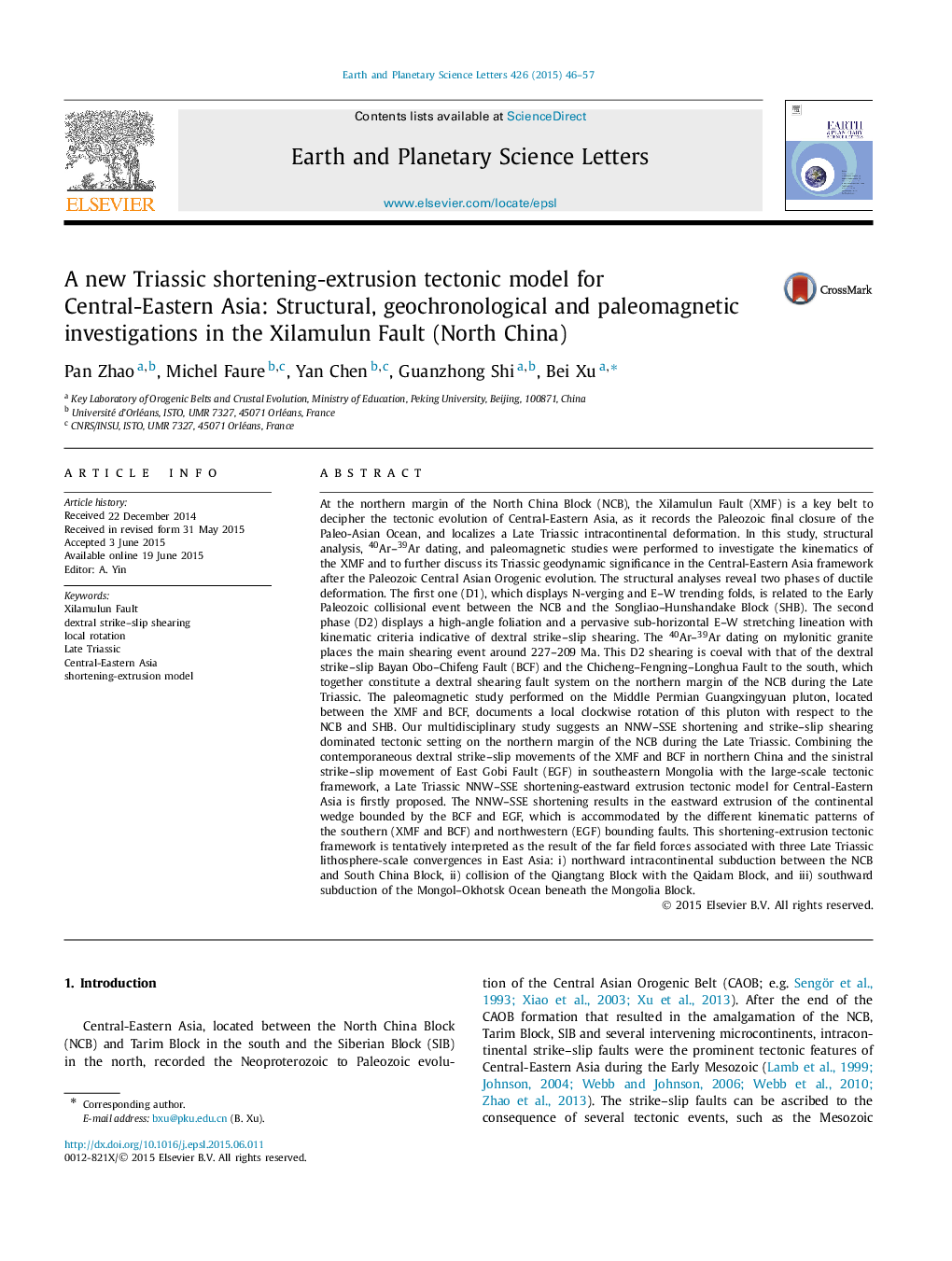| کد مقاله | کد نشریه | سال انتشار | مقاله انگلیسی | نسخه تمام متن |
|---|---|---|---|---|
| 6428117 | 1634730 | 2015 | 12 صفحه PDF | دانلود رایگان |

- The Xilamulun Fault displays dextral strike-slip shearing during the Late Triassic.
- Dextral strike-slip shearing produced clockwise rotations of fault blocks.
- A Triassic shortening-extrusion model for Central-Eastern Asia is firstly proposed.
At the northern margin of the North China Block (NCB), the Xilamulun Fault (XMF) is a key belt to decipher the tectonic evolution of Central-Eastern Asia, as it records the Paleozoic final closure of the Paleo-Asian Ocean, and localizes a Late Triassic intracontinental deformation. In this study, structural analysis, 40Ar-39Ar dating, and paleomagnetic studies were performed to investigate the kinematics of the XMF and to further discuss its Triassic geodynamic significance in the Central-Eastern Asia framework after the Paleozoic Central Asian Orogenic evolution. The structural analyses reveal two phases of ductile deformation. The first one (D1), which displays N-verging and E-W trending folds, is related to the Early Paleozoic collisional event between the NCB and the Songliao-Hunshandake Block (SHB). The second phase (D2) displays a high-angle foliation and a pervasive sub-horizontal E-W stretching lineation with kinematic criteria indicative of dextral strike-slip shearing. The 40Ar-39Ar dating on mylonitic granite places the main shearing event around 227-209 Ma. This D2 shearing is coeval with that of the dextral strike-slip Bayan Obo-Chifeng Fault (BCF) and the Chicheng-Fengning-Longhua Fault to the south, which together constitute a dextral shearing fault system on the northern margin of the NCB during the Late Triassic. The paleomagnetic study performed on the Middle Permian Guangxingyuan pluton, located between the XMF and BCF, documents a local clockwise rotation of this pluton with respect to the NCB and SHB. Our multidisciplinary study suggests an NNW-SSE shortening and strike-slip shearing dominated tectonic setting on the northern margin of the NCB during the Late Triassic. Combining the contemporaneous dextral strike-slip movements of the XMF and BCF in northern China and the sinistral strike-slip movement of East Gobi Fault (EGF) in southeastern Mongolia with the large-scale tectonic framework, a Late Triassic NNW-SSE shortening-eastward extrusion tectonic model for Central-Eastern Asia is firstly proposed. The NNW-SSE shortening results in the eastward extrusion of the continental wedge bounded by the BCF and EGF, which is accommodated by the different kinematic patterns of the southern (XMF and BCF) and northwestern (EGF) bounding faults. This shortening-extrusion tectonic framework is tentatively interpreted as the result of the far field forces associated with three Late Triassic lithosphere-scale convergences in East Asia: i) northward intracontinental subduction between the NCB and South China Block, ii) collision of the Qiangtang Block with the Qaidam Block, and iii) southward subduction of the Mongol-Okhotsk Ocean beneath the Mongolia Block.
150
Journal: Earth and Planetary Science Letters - Volume 426, 15 September 2015, Pages 46-57